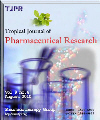
|
Tropical Journal of Pharmaceutical Research
Pharmacotherapy Group, Faculty of Pharmacy, University of Benin, Benin City, Nigeria
ISSN: 1596-5996
EISSN: 1596-5996
Vol. 16, No. 3, 2017, pp. 543-552
|
 Bioline Code: pr17070
Bioline Code: pr17070
Full paper language: English
Document type: Research Article
Document available free of charge
|
|
|
Tropical Journal of Pharmaceutical Research, Vol. 16, No. 3, 2017, pp. 543-552
| en |
Anti-diabetic activity-guided screening of aqueous-ethanol Moringa oleifera  extracts and fractions: Identification of marker compounds extracts and fractions: Identification of marker compounds
Irfan, Hafiz Muhammad; Asmawi, Mohd Zaini; Khan, Nurzalina Abdul Karim; Sadikun, Amirin & Mordi, Mohd Nizam
Abstract
Purpose: To explore the anti-diabetic effects of Moringa oleifera extracts and fractions, and to identify
their active/marker compounds.
Methods: Five different aqueous ethanol extracts (95, 75, 50, 25 %v/v and 100 % water) of Moringa
oleifera were given orally to normal rats to assess their hypoglycemic activities and effect on
intraperitoneal glucose tolerance test (IPGTT) data. Rats with streptozotocin-induced diabetes were
used to assess acute and sub-chronic anti-hyperglycemic activities. The most active extract was further
subjected to liquid-liquid fractionation into hexane, chloroform, ethyl acetate, butanol, and water; these
fractions were screened for anti-diabetic activities. The most active extract, and fractions thereof, were
then subjected to qualitative and quantitative phytochemical analysis. Standardization was achieved via
thin layer chromatography (TLC) and high-performance liquid chromatography (HPLC), and used to
identify marker compounds.
Results: Of all the extracts and fractions, 95 % (v/v) ethanol extract (at 1,000 mg/kg) and the butanol
fraction thereof (at 500 mg/kg) were the most active, reducing blood glucose concentration after one-time
(acute) administration to diabetic rats (p < 0.01). No significant hypoglycemic activity was apparent,
and the materials had no effect on IPGTT performance by normal rats. TLC and HPLC identified
quercetin 3-β-D-glucoside, kaempferol-3-O-glucoside, and cryptochlorogenic acid.
Conclusion: An M. oleifera leaf extract exhibited anti-hyperglycaemic activity in diabetic rats only. This
effect was likely attributable to cryptochlorogenic acid, quercetin 3-β-D-glucoside, and kaempferol 3-O-glucoside.
Keywords
Anti-diabetic; Moringa oleifera; Cryptochlorogenic acid; Quercetin; 3-β-D-glucoside; Kaempferol 3-O-glucoside; Streptozotocin
|
| |
© Copyright 2017 - Pharmacotherapy Group, Faculty of Pharmacy, University of Benin, Benin City, 300001 Nigeria.
Alternative site location: http://www.tjpr.org
|
|
